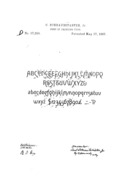Cut by Gustave F. Schroeder while at the Central Type Foundry after commercial lettering identified by James A. St. John. The patent for it was filed 1886-02-10.
Copied under license in wood by Morgans & Wilcox as Art Gothic (it is shown in their 1890 specimen book, on p. 6).
My thanks to Stephen O. Saxe for having identified this typeface, its origins, and its patent number in a discussion on the LETPRESS list on 2013-12-28.
"[Schroeder's] employers (Schraubstädter & St. John) were men who could both instruct and suggest, and in a short time his genius was recognized. It may be said that he originated a new departure in letter designing, and his first series, the well-known Art Gothic, was the most severely criticised and most highly praised of any style in recent years. It soon made its way in popular favor, and has been bought and worn out three or four times in some offices. The suggestion for this series was discovered by Mr. St. John on the label of a soap box."
{Loy, William E. "Designers and Engravers of Type" No. 11, Gustav[e] F. Schroeder. Inland Printer, Vol. 22, No. 3 (1898-12): 338}
I am unaware of any futher information concerning the commercial lettering on the soap box which inspired this type.
The type was patented 1887-05-17 by Carl Schraubstadter, co-owner of the Central:

US Design Patent D17,350 (1887)
US design patent 17,350, "Design for a Font of Printing-Type." Issued 1887-05-17 to Carl Schraubstadter. Filed 1886-02-10 as application serial number 191,520.
In modern works it is shown in the Saxe/Johnston edition of Loy, p. 76.
It was shown in The Inland Printer, Vol. 3, No. 7 (1886-04): 410. Here is a scan of that showing:
(The image above links to a PDF version of a full-resolution JPEG conversion of this image (3.7 Megabytes). As a PDF, it should scale reasonably well in viewers. I scanned this at 600dpi from an original (although regrettably in greyscale; I wish now that I had scanned it RGB). Here is the original scan, presented losslessly as a PNG image file (9 Megabytes): inland-printer-v03n07-1886-04-uw-0600grey-410-type-specimens-central-type-foundry-crop-4392x5868.png )
This 1886 Inland Printer showing was also reprinted in {Annenberg, Maurice, ed. A Typographical Journey through The Inland Printer: 1883-1900 Baltimore, MD: Maran Publishing Services, 1977} , p. 102.
"Art Gothic" and "Art Gothic Bold" (under their original names) were offered for photolettering service by Dan X. Solo. They are shown briefly in The Solotype Catalog (NY: Dover Publications, 1992): 10, 42.
This type has been copied at least three times in the digital era.
A copy by URW preserved its name ("Art Gothic").
A 2007 copy by "HiH Retrofonts" www.hihretro.com not only preserves its name (Art Gothic) but also acknowledges its source at Central and tries to trace its origins. See: www.hihretro.comfonts/fontpages/artgoth.html In general the HiH version deserves credit for unusually good research. It's nice to see this work carefully done.
However, HiH only traces it as far back as a 1907 Inland Printer article by Bullen, which illustrates it only in passing, and therefore they miss its attribution to Schroeder and St. John (and suggest a date for it which is too early). While they do not cite this article precisely, I believe that it is Bullen, Henry L. "Discursions of a Retired Printer," No. X ("Illustrations of the Progress of American Type-Designs from 1870 to 1890 - Roman Book Type Invented in America - James A. St. John, A Successful Typefounder") Inland Printer, Vol. 39, No. 2 (May, 1907): 193-198 . It appears there as Example No. 50 in a series of comparative charts on types. A part of this series of charts containing this example was reprinted in Rob Roy Kelly's American Wood Type: 1828-1900 (p. 204), and it is probably upon this reprint that HiH relied. It contains a short specimen of Art Gothic with an attribution to the Central Type Foundry.
HiH also cross-reference Art Gothic to a later wood type, Hamilton No. 232. They identify it from an unspecified 1892 Hamilton catalogue. The earliest Hamilton catalog which is presently digitized and online and which shows No. 232 is their 1899 Catalog No. 14, digitized by Unicorn Graphics: Museum of Wood Types & Ornaments: http://www.unicorngraphics.com/wood%20type%20museum.asp Hamilton No. 232, as shown for example in the 10 line body size on p. 76 of this catalogue, is similar to, but by no means the same as, Art Gothic.
Curiously, HiH does not identify the Art Gothic made in wood under license to Central by Morgans & Wilcox. (even though this is identified in Kelly (p. 157) and called out in his index).
They also identify it as used in a couple of later pubications and specimens (1897, 1902).
A more recent copy by Gerald Gallo was produced under the name "Dexterous" with no indication that it was not his original work ( www.graphicsbygallo.com).
All of the type specimen documents reproduced or extracted from here are in the public domain due to their publication without copyright notice when such notice was required, or the failure to renew copyright as was then required, or the expiration of all possible copyright. The reproductions of/from them here remain in the public domain.
All portions of this document not noted otherwise are Copyright © 2012 by David M. MacMillan and Rollande Krandall.
Circuitous Root is a Registered Trademark of David M. MacMillan and Rollande Krandall.
This work is licensed under the Creative Commons "Attribution - ShareAlike" license. See http://creativecommons.org/licenses/by-sa/3.0/ for its terms.
Presented originally by Circuitous Root®
Select Resolution: 0 [other resolutions temporarily disabled due to lack of disk space]